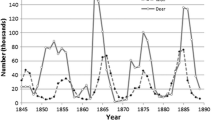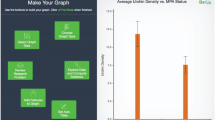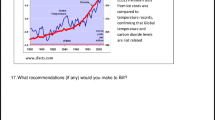Abstract
Studies of scientists show that graphs and graphing are central to the processes and products of science. It does not surprise us that recent reform documents propose the development of competency in using and reading graphs as an important aspect of learning science and about science. Reform documents propose that (a) public school science classrooms have students engage in hands-on inquiry practices, in which they summarize investigative activities using graphs, and (b) education students take science courses instructed by science department faculty members. Past research has demonstrated that pre-service secondary teachers do not, on their own, default to the graphical summarizing and interpretive practices of scientists. We examined the graphical analysis practices of pre-service elementary teachers and science graduates on two graphing tasks and concluded that there were few differences between those two groups in their interpretations. We propose a model to understand the differences between these groups and more experienced groups of graph interpreters. We conclude that taking the lecture-oriented science courses common to science programs does not necessarily improve education students’ competencies at summarizing data or interpreting graphs and that they need to engage in scaffolded, research-oriented activities themselves.
Résumé
La recherche ethnographique des sciences démontre que les graphiques et leur utilisation sont au cœur du processus et des résultats du travail scientifique. Il ne nous surprend pas que dans les récents documents politiques proposant la réforme scolaire le développement des compétences de l’utilisation et de la lecture des graphiques est un des points centraux de l’apprentissage du savoir scientifique et du savoir sur les sciences. D’après les documents de réforme, les élèves des écoles publiques doivent avoir des possibilités de s’engager dans des activités pratiques qu’ils résument en utilisant les graphiques et les futurs maîtres doivent prendre des cours de sciences enseignés dans les départements de sciences à l’université. La recherche en éducation a déjà démontré que les futurs enseignants (qui avaient pris des cours de sciences offerts dans les départements des sciences plutôt que dans les facultés des sciences de l’éducation) n’utilisent pas automatiquement les pratiques d’interprétation des graphiques que les scientifiques emploient de façon systématique. Néanmoins, il n’est pas déraisonnable de penser que ces futurs enseignants de sciences, ayant suivi plus de cours de sciences que les futurs instituteurs, soient plus proches des scientifiques dans l’interprétation des graphiques. Les documents de réforme suggèrent que le fait de prendre plus de cours enseignés dans les facultés de sciences améliore automatiquement les compétences scientifiques. Afin de vérifier cette hypothèse nous avons comparé la pratique de l’analyse des graphiques des futurs instituteurs avec celle des individus qui ont reçu une formation scientifique à l’université (licence es sciences) et qui avaient donc pris plus de cours de sciences. Nos analyses démontrent qu’il n’y a que peu de différences dans les interprétations données par les membres de ces deux groupes. Pour comprendre ces résultats, nous proposons un modèle théorique qui tient compte aussi de l’interprétation de ces mêmes graphiques donnée par des scientifiques. Nous tirons la conclusion que prendre plus de cours magistraux de sciences n’améliore pas nécessairement les compétences des futurs instituteurs dans l’interprétation des graphiques. Pour améliorer ces compétences, les futurs instituteurs doivent s’engager dans des projets de recherche qu’ils développent eux-mêmes et qui incluent la spécification de variables, la collecte de données, l’interprétation de ces données en utilisant des tableaux et des graphiques, et la défense de leurs résultats face à la communauté de pratique constituée par leurs pairs et leurs professeurs et dont ils font partie.
Similar content being viewed by others
References
American Association for the Advancement of Science. (1993). Benchmarks for science literacy. New York: Oxford University Press.
Bastide, F. (1990). The iconography of scientific texts: Principles of analysis. In M. Lynch & S. Woolgar (Eds.), Representation in scientific practice (pp. 187–229). Cambridge, MA: MIT Press.
Bowen, G.M., & Roth, W.-M. (1998). Lecturing graphing: What features of lectures contribute to student difficulties in learning to interpret graphs? Research in Science Education, 28(1), 77–90.
Bowen, G.M., Roth, W.-M., & McGinn, M.K. (1999). Interpretations of graphs by university biology students and practising scientists: Towards a social practice view of scientific re-presentation practices. Journal of Research in ScienceTeaching, 36, 1020–1043.
Eickmeier, W.G. (1978). Photosynthetic pathway distributions along an aridity gradient in Big Bend National Park, and implications for enhanced resource partitioning. Photosynthetica, 12, 290–297.
Greeno, J.G. (1988). Situated activities of learning and knowing in mathematics. In M. Behr, C. Lacampagne, & M.M. Wheeler (Eds.), Proceedings of the 10th Annual Meeting of the PME-NA (pp. 481–521). DeKalb, IL: IGPME.
Guba, E., & Lincoln, Y. (1989). Fourth generation evaluation. Beverly Hills, CA: Sage.
National Council of Teachers of Mathematics. (1989). Curriculum and evaluation standards for school mathematics. Reston, VA: Author.
National Research Council. (1994). National science education standards. Washington, DC: National Academy Press.
Ricceur, P. (1991). From text to action: Essays in hermeneutics, IL Evanston, IL: Northwestern University Press.
Roth, W.-M. (1996). Where is the context in contextual word problems? Mathematical practices and products in Grade 8 students’ answers to story problems. Cognition and Instruction, 14, 487–527.
Roth, W.-M., & Bowen, G.M. (1994). Mathematization of experience in a Grade 8 open-inquiry environment: An introduction to the representational practices of science. Journal of Research in Science Teaching, 31(3), 293–318.
Roth, W.-M., & Bowen, G.M. (1999). Complexities of graphical representations during ecology lectures: An analysis rooted in semiotics and hermeneutic phenomenology. Learning and Instruction, 9, 235–255.
Roth, W.-M., & Bowen, G.M. (2001). Professionals read graphs: A semiotic analysis. Journal for Research in Mathematics Education, 32, 159–194.
Roth, W.-M., & Bowen, G.M. (in press). When are graphs ten thousand words worth? An expert/expert study. Cognition and Instruction.
Roth, W.-M., Bowen, G.M., & Masciotra, D. (2002). From thing to sign and ‘natural object’: Toward a genetic phenomenology of graph interpretation. Science, Technology, & Human Values, 27, 327–356.
Roth, W.-M., Lee, Y.J., & Peebles, D. (2003). Interpreting unfamiliar graphs: A generative, activity-theoretic model. In W.-M. Roth (Ed.), CONNECTIONS ’03 (pp. 31–58). Victoria, BC: Faculty of Education.
Roth, W.-M., & McGinn, M.K. (1998). Inscriptions: A social practice approach to ‘representations.’ Review of Educational Research, 68, 35–59.
Roth, W.-M., McGinn, M.K., & Bowen, G.M. (1998). How prepared are preservice teachers to teach scientific inquiry? Levels of performance in scientific representation practices. Journal of Science Teacher Education, 9(1), 25–48.
Roth, W.-M., & Tobin, K. (1996). Aristotle and natural observation versus Galileo and scientific experiment: An analysis of lectures in physics for elementary teachers in terms of discourse and inscriptions. Journal of Research in Science Teaching, 33(2), 135–137.
Roth, W.-M., Tobin, K., & Shaw, K. (1997). Cascades of inscriptions and the re-presentation of nature: How numbers, tables, graphs, and money come to re-present a rolling ball. International Journal of Science Education, 19, 1075–1091.
Tabachneck-Schijf, H.J.M., Leonardo, A.M., & Simon, H.A. (1997). CaMeRa: A computational model for multiple representations. Cognitive Science, 21, 305–350.
Woolgar, S. (1990). Time and documents in researcher interaction: Some ways of making out what is happening in experimental science. In M. Lynch & S. Woolgar (Eds.), Representation in scientific practice (pp. 123–152). Cambridge, MA: MIT Press.
Author information
Authors and Affiliations
Rights and permissions
About this article
Cite this article
Bowen, G.M., Roth, WM. Graph Interpretation Practices of Science and Education Majors. Can J Sci Math Techn 3, 499–512 (2003). https://doi.org/10.1080/14926150309556585
Published:
Issue Date:
DOI: https://doi.org/10.1080/14926150309556585




